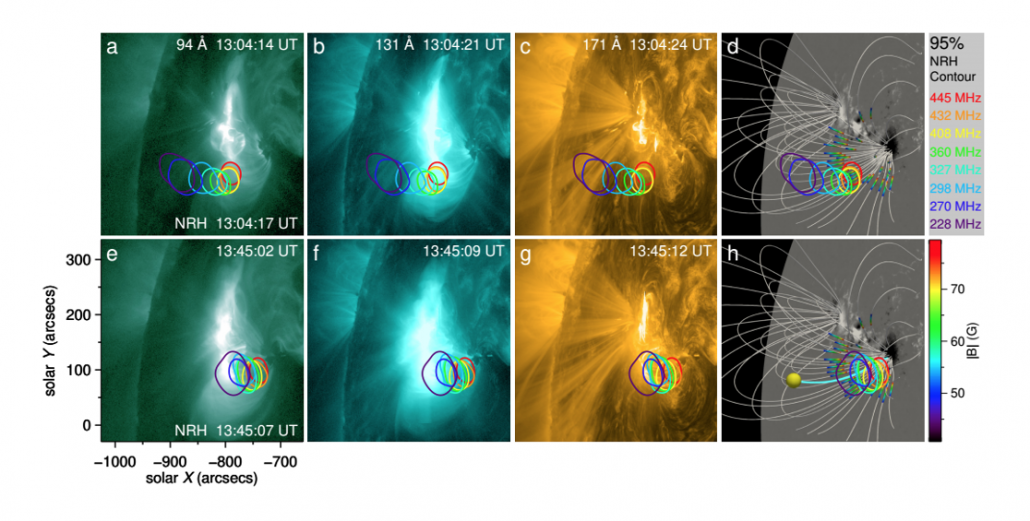Decimetric broadband radio bursts (with frequencies of hundreds of MHz to a few GHz) have been observed from the Sun and other flaring stars. In the solar case, such bursts have been classified as the decimetric type-IV (t-IVdm) bursts. Their spectra often contain substantial fine structures, such as pulsations, spikes, and various absorption structures. This makes them distinct from their metric and centimetric counterparts.
Due to the lack of imaging data at decimetric wavelengths, earlier studies determined the source field orientation based on the leading sunspot hypothesis (Aschwanden 1986; Zlobec et al. 1987). This leads to contradictory conclusions on the mechanism of t-IVdm bursts. Over the past eight decades of solar radio astronomy, only solar spikes that are highly transient, highly polarized, and extremely bright are widely attributed to electron cyclotron maser emission (ECME), while several other types of coherent solar bursts, such as type-I, II, and III, have been attributed to plasma emission.
We analyzed a flare-induced t-IVdm burst on 20110924 with medium-strong levels of polarization and from sources near a sunspot. The event was observed by NRH at several imaging frequencies and by SDO/AIA at EUV passbands. The purpose is to identify the underlying radiation mechanism.

Figure 1: Overview of the t-IVdm radio burst on 2011 September 24. (a) GOES soft X-ray fluxes of the M7.1-class flare at 1.0–8.0 Å. (b) The dynamic spectra combining the data from the San Vito observatory (100–175 MHz), the Bleien observatory (175–870 MHz), and the Ondrejov observatory (870–2000 MHz). Bursts I and II are two components of the t-IVdm event. (c) The temporal profiles of the maximum TB and the degree of polarization (d) with a 10 s cadence at eight NRH frequencies.
The event consists of two major sub-bursts (bursts I and II), each lasting ∼20 minutes. The observations reveal three features: (1) Both burst components are highly intermittent, with well-defined upper and lower frequency cutoffs at ∼1–2 GHz and 200–300 MHz, respectively. (2) The maximum brightness temperature (TB) is ∼2 × 1011 K for Burst I and ∼4×1010 K for Burst II. (3) The polarization is left-handed with levels
reaching ∼70%–100%, with an overall increasing trend with frequency. Based on these observations, we conclude that the emission is coherent since the incoherent gyrosynchrotron radiation of solar flares cannot yield such intermittency with high TB > 1011 K and strong polarization at such frequencies (e.g., Dulk 1985).

Figure 2: The AIA and HMI data of the event. (a)–(c) and (e)–(g) The AIA images at 94, 131, and 171 Å are overlaid with NRH 95% contours of the maximum TB
at eight frequencies (228–445 MHz) for representative moments of bursts I and II. (d) and (h) The HMI magnetogram superposed by extrapolated NLFFF
field lines. The colored sections of field lines correspond to the field strengths increasing from ∼40.7 to ∼79.5 G and the corresponding 2 Ωce increasing from 228 to 445 MHz. Colored circles display NRH 95% contours at 13:04:17 (d) and 13:45:07 UT (h). The yellow sphere crossing the cyan field line marks the location where
energetic electrons are injected for the particle-transport simulation.
The NRH sources moved systematically during the burst, exhibiting at least two leaps which indicate the start of bursts I and II. Around 13:00 UT, the sources moved to the region above the flaring loops, and at ∼13:20 UT, they leaped toward the western leg of the loops, right above the rightmost sunspot with a negative polarity. During the whole process, the NRH sources aligned well with each other, and higher-frequency sources are closer to the disk.
We draw two major conclusions: (1) NRH sources of both bursts (I and II) lie along the field lines pointing toward the sunspot with strong left-handed polarization (Figure 1(d)), so both bursts are of X mode, and (2) the sources align well with
the colored 2 Ωce section. Thus, the most likely radiation mechanism is the harmonic X mode (X2) via ECME since the alternative coherent plasma emission process would produce O mode for the fundamental branch or weak polarization for the
harmonic branch (e.g., Chen et al. 2022).
We further modeled the transport of downward-streaming energetic electrons along a coronal loop. We found that most electrons get mirrored in converging sunspot fields within the altitude range of 20–100 Mm. This agrees with the well-defined spectral ranges of such bursts. The ECME-radiating energetic electrons exhibit a shell-like velocity distribution function (VDF) instead of the generally presumed loss-cone distribution.
This study provides essential evidence that the flare-induced t-IVdm burst is induced by ECME in the harmonic X mode, and greatly expands the application of ECME in solar radio astronomy and provides solar samples for similar bursts from other flaring stars.
Based on the recent paper by Lv M., Zhong Z., Kong X., Ning, H., Yu, F., Wang B., Tan B., Victor, M., Alexey, K., Song, H., Zheng R., Chen Y., A Flare-related Decimetric Type-IV Radio Burst Induced by the X2 Radiation of Electron Cyclotron Maser Emission, ApJL, 989, L24, DOI: https://doi.org/10.3847/2041-8213/adf5c6
References
Aschwanden, M.: 1986, SoPh, 104, 57
Zlobec, P., Messerotti, M., Li, H. et al.: 1987, SoPh, 114, 375
Dulk, G.: 1985, ARA&A, 23, 169
Chen, Y., Zhang, Z., Ni, S., et al.: 2022, ApJL, 924, L34
